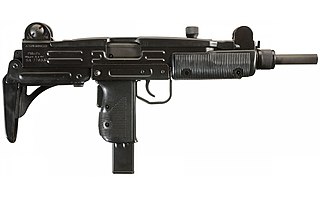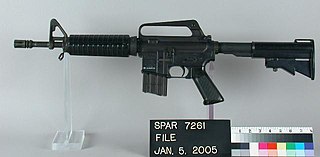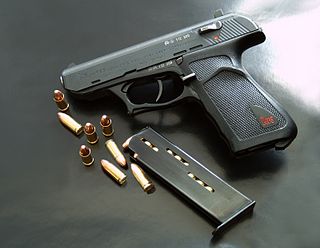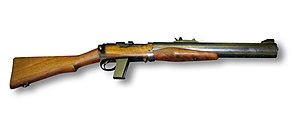
A carbine is a long gun that has a barrel shortened from its original length. Most modern carbines are rifles that are compact versions of a longer rifle or are rifles chambered for less powerful cartridges.

The Uzi is a family of Israeli open-bolt, blowback-operated submachine guns and machine pistols first designed by Major Uziel "Uzi" Gal in the late 1940s, shortly after the establishment of the State of Israel. It is one of the first weapons to incorporate a telescoping bolt design, which allows the magazine to be housed in the pistol grip for a shorter weapon.

The Lee–Enfield is a bolt-action, magazine-fed repeating rifle that served as the main firearm of the military forces of the British Empire and Commonwealth during the first half of the 20th century, and was the standard service rifle of the British Armed Forces from its official adoption in 1895 until 1957.

The STEN is a British submachine gun chambered in 9×19mm which was used extensively by British and Commonwealth forces throughout World War II and during the Korean War. The Sten paired a simple design with a low production cost, facilitating mass production to meet the demand for submachine guns.
The Rifle No. 5 Mk I, nicknamed the "Jungle Carbine" for its use in jungle warfare, was a bolt action carbine derivative of the British Lee–Enfield No. 4 Mk I. It was developed per jungle fighting experiences in the Pacific War that led the British to decide "a rifle shorter and lighter" than the regular Lee–Enfield was critical for better mobility. Produced between March 1944 and December 1947, the Jungle Carbine was intended for and used in jungle environments where it gained its nickname. It notably saw widespread usage in on various sides of postwar colonial conflicts such as the Indonesian National Revolution, Malayan Emergency, and Vietnam War well into the 1960s, with sporadic use reported to have continued in several secessionist wars such as the Bangladesh Liberation War and Bougainville conflict throughout the rest of the 20th century.

The Military Armament Corporation Model 10, officially abbreviated as "M10" or "M-10", and more commonly known as the MAC-10, is a compact, blowback operated machine pistol/submachine gun that was developed by Gordon Ingram in 1964. It is chambered in either .45 ACP or 9mm. A two-stage suppressor by Sionics was designed for the MAC-10, which not only abates the noise created but makes it easier to control on full automatic.

The Heckler & Koch MK 23, MK 23 MOD 0, Mark 23, or USSOCOM MARK 23 is a semi-automatic large-frame pistol chambered in .45 ACP, designed specifically to be an offensive pistol. The USSOCOM version of the MK23 came paired with a laser aiming module (LAM) and suppressor. The USSOCOM MK23 was adopted by the United States Special Operations Command (USSOCOM) for special operations units, beating out the nearest competitor, Colt's OHWS. Development of the pistol began in 1991 as special operations representatives identified the need for an "Offensive Handgun Weapons System—Special Operations Peculiar", and delivery of the pistols began in May 1996 to the special operation units.

The Colt Automatic Rifle-15 or CAR-15 is a family of M16 rifle–based firearms marketed by Colt in the 1960s and early 1970s. However, the term "CAR-15" is most commonly associated with the Colt Commando ; these select-fire carbines have ultrashort 10.5-inch (270 mm) and 11.5-inch (290 mm) barrels with over-sized flash suppressors.

The Sterling submachine gun is a British submachine gun (SMG). It was tested by the British Army in 1944–1945, but did not start to replace the Sten until 1953. A successful and reliable design, it remained standard issue in the British Army until 1994, when it began to be replaced by the L85A1, a bullpup assault rifle.

The Lee–Metford is a British bolt action rifle which combined James Paris Lee's rear-locking bolt system and detachable magazine with an innovative seven-groove rifled barrel designed by William Ellis Metford. It replaced the Martini–Henry as the standard service rifle of the British Empire in 1888, following nine years of development and trials, but remained in service for only a short time until replaced by the Lee–Enfield.
Blowback is a system of operation for self-loading firearms that obtains energy from the motion of the cartridge case as it is pushed to the rear by expanding gas created by the ignition of the propellant charge.

The Welrod is a British bolt action, magazine-fed, suppressed pistol devised during the Second World War by Major Hugh Reeves at the Inter-Services Research Bureau. Station IX, being based near Welwyn Garden City, gave the Welrod its unusual name, being derived from "Wel" from "Welwyn Garden City" and "rod", gangland slang for gun, as a way to obscure its purpose.

The Claridge Hi-Tec and its antecedent the Goncz High-Tech Long Pistol are semi-automatic pistols designed by Hungarian inventor Lajos John Goncz. This unique firearm features a telescopic bolt design encased in a tubular upper receiver with a forged steel frame, button rifled match barrels, and 16-round magazines standard.

The KRISS Vector is a series of weapons based upon the parent submachine gun design developed by the American company KRISS USA, formerly Transformational Defense Industries (TDI).

The Charlton automatic rifle was a fully automatic conversion of the Lee–Enfield rifle, designed by New Zealander Philip Charlton in 1941 to act as a substitute for the Bren and Lewis gun light machine guns which were in severely short supply at the time.

Auto-Ordnance was a U.S. arms development firm founded by retired Colonel John T. Thompson of the United States Army Ordnance Department in 1916. Auto-Ordnance is best known for the Thompson submachine gun, used as a military weapon by the Allied forces in World War II, and also notorious as a gangster weapon used during the Roaring Twenties.
The Rieder automatic rifle was a fully automatic Lee–Enfield SMLE rifle conversion of South African origin. The Rieder device could be installed quickly with the use of simple tools. A similar weapon of New Zealand origin was the Charlton automatic rifle.

The HK P9 is a semi-automatic pistol from Heckler & Koch in 9×19mm Parabellum, .45 ACP, and 7.65×21mm Parabellum and the first to use a variation of H&K's roller delayed blowback system in a pistol format and polygonal rifling now common in H&K designs.

















